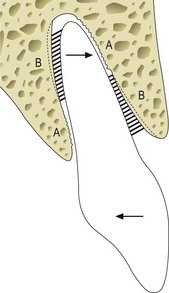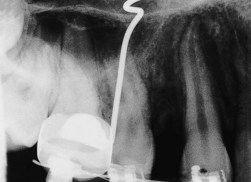20 Tooth movement and related problems
Case 1
Summary
Operator factors
 What cellular response is there following activation of the spring to retract
What cellular response is there following activation of the spring to retract  by tipping movement?
by tipping movement?
The consequence of the spring activation is the setting up of pressure and tension zones within the periodontal ligament. Half of the periodontal ligament is stressed with maximum pressure created at the alveolar crest in the direction of movement and at the diagonally opposite apical area (Fig. 20.1).
Tension zones
 How would you manage the problem in this case?
How would you manage the problem in this case?
Management is specific to each cause. The action taken may be one or more of the following:
The need for full-time wear of the appliance must be emphasized to the patient/parent. They must be made aware that treatment will be ceased unless full cooperation is forthcoming.
Show the patient how to insert the appliance with the spring positioned correctly and explain the action of the spring. Ensure that the appliance is not being removed by the spring.
Remove any acrylic or wire obstruction to tooth movement. This may involve remaking the appliance to an improved design.
Add to a flat anterior biteplane or buccal capping to disengage the occlusion, if this is hampering tooth movement.
Ask the patient and check their case records regarding any noted problem with the extraction of  . If indicated, take a periapical radiograph of
. If indicated, take a periapical radiograph of  extraction site to check for a retained root fragment. If this is detected, seek an oral surgical opinion regarding its removal or whether it could be left in situ and its position monitored radiographically.
extraction site to check for a retained root fragment. If this is detected, seek an oral surgical opinion regarding its removal or whether it could be left in situ and its position monitored radiographically.
 . If indicated, take a periapical radiograph of
. If indicated, take a periapical radiograph of  extraction site to check for a retained root fragment. If this is detected, seek an oral surgical opinion regarding its removal or whether it could be left in situ and its position monitored radiographically.
extraction site to check for a retained root fragment. If this is detected, seek an oral surgical opinion regarding its removal or whether it could be left in situ and its position monitored radiographically.Check  is not ankylosed. This is unlikely in this case as some movement of
is not ankylosed. This is unlikely in this case as some movement of  has occurred since
has occurred since  was extracted.
was extracted.
 is not ankylosed. This is unlikely in this case as some movement of
is not ankylosed. This is unlikely in this case as some movement of  has occurred since
has occurred since  was extracted.
was extracted.Stay updated, free dental videos. Join our Telegram channel

VIDEdental - Online dental courses


 , following extraction of
, following extraction of  . Tooth movement has been very slow with no movement recorded at the last two visits.
. Tooth movement has been very slow with no movement recorded at the last two visits.
 .
. is directly buccally into contact with the cortical plate rather than through the cancellous corridor of bone.
is directly buccally into contact with the cortical plate rather than through the cancellous corridor of bone.
 by tipping movement?
by tipping movement?


 .
.

